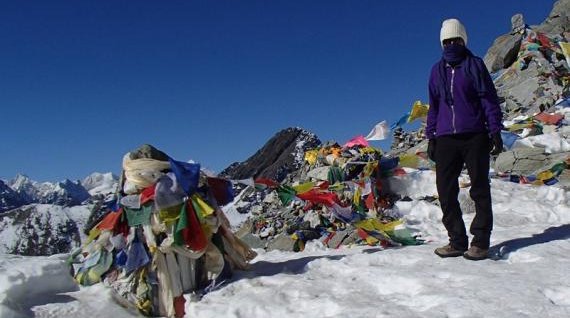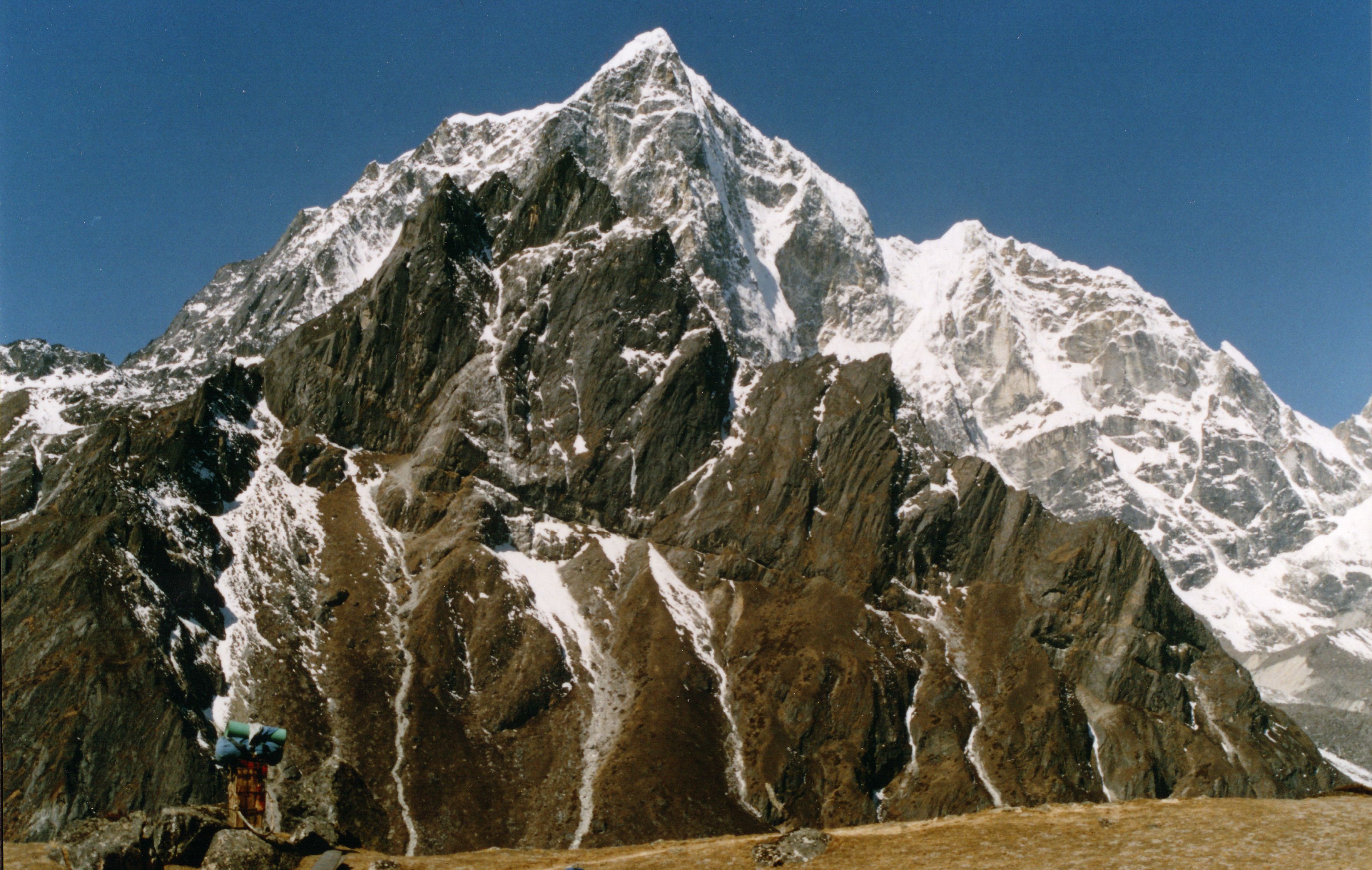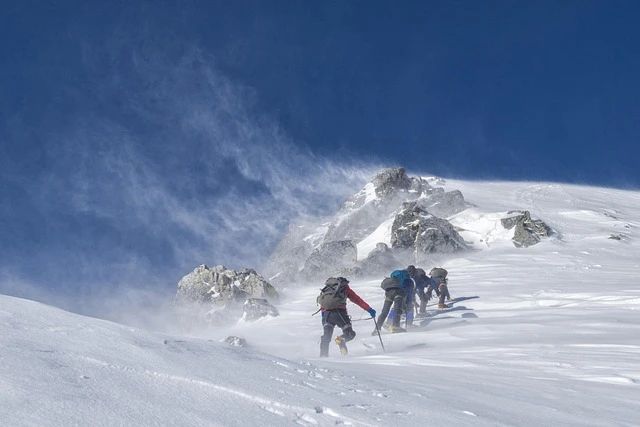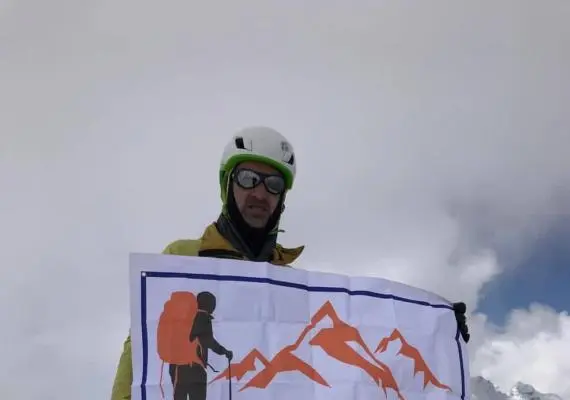The moment you stand atop Kongma La Pass at 5,535 meters, gasping in the thin air while surrounded by the world's highest peaks, you realize the Everest 3 Pass Trek isn't just another Himalayan adventure. It's the ultimate test of endurance that rewards you with views that less than 5% of Everest region trekkers ever witness.
This extraordinary circuit combines three breathtaking high passes—Kongma La (5,535m), Cho La (5,420m), and Renjo La (5,360m)—with iconic destinations like Everest Base Camp. Many seasoned trekkers call it the "Himalayan Triple Crown" for good reason.
What Makes the Everest Three Passes Trek Special?
The Three High Passes Trek delivers the most comprehensive Everest region experience available. Unlike the crowded EBC route, this adventure takes you through remote valleys and ancient glaciers across 160 kilometers over 17-21 days.
Unmatched Mountain Views:
- 360-degree panoramas from three passes above 5,300m
- Four 8,000m+ peaks visible (Everest, Lhotse, Makalu, Cho Oyu)
- Sunrise views from Kala Patthar (5,555m) and Gokyo Ri (5,357m)
- Close encounters with Ama Dablam, Pumori, and Nuptse
- Photographic opportunities are impossible on standard routes
The cultural immersion goes far beyond typical tea house stays. Traditional Sherpa villages like Thame and Marlung preserve ancient lifestyles rarely witnessed by mainstream trekkers.
Cultural Highlights:
- Tengboche Monastery ceremonies with Buddhist chants
- Remote settlements with fewer than 100 monthly visitors
- Authentic yak herding communities
- Traditional stone houses with carved wooden windows
- Local cheese production facilities in Thame
Natural wonders reveal themselves at every turn on this epic journey. The six Gokyo Lakes shimmer with turquoise glacial waters while the Ngozumpa Glacier—Nepal's longest—stretches endlessly below.
Natural Attractions:
- Pristine high-altitude lakes reflecting surrounding peaks
- Khumbu Icefall views fromEverest Base Camp
- Alpine meadows blooming with wildflowers (spring)
- Ancient rhododendron forests below 4,000m
- Wildlife including Himalayan tahr and snow leopards
Understanding the Three Passes: Your High-Altitude Challenge
Each pass presents unique challenges testing different aspects of your trekking abilities. Understanding these differences helps you prepare mentally and physically for success.
Kongma La Pass (5,535m) - The Highest Challenge
Kongma La stands as the highest and most technically demanding pass. The ascent from Chhukung requires 4-5 hours of steep climbing through increasingly challenging terrain.
Technical Requirements:
- Initial rocky scramble through loose scree
- Glacier crossing demanding careful foot placement
- Final push to prayer flag-adorned summit
- Route finding skills in poor visibility
- Crampon use mandatory in winter/spring
Spring conditions bring heavy snow making this pass particularly challenging. Success rates hover around 85% with proper preparation, dropping to 60% in winter months.
Seasonal Difficulty Variations:
- Spring (Mar-May): Heavy snow, crampons essential
- Summer (Jun-Aug): Moderate difficulty, afternoon storms
- Autumn (Sep-Nov): Minimal snow, 90% success rate
- Winter (Dec-Feb): Extreme conditions, often impassable
Cho La Pass (5,420m) - The Icy Gateway
Cho La connects Gokyo Valley with Khumbu Valley through a dramatic glacier crossing. Morning starts prove absolutely crucial as frozen surfaces provide better traction.
Critical Safety Factors:
- Hidden crevasses during heavy snow periods
- Steep descent to Dzongla requiring poles
- Rapid weather changes at the col
- Afternoon rockfall danger
- Microspikes are mandatory in most seasons
The western approach from Thangnak adds complexity with the Cho La Glacier crossing. Your guide's experience becomes invaluable in navigating the ever-changing ice formations.
Timing Strategies:
- Start before 6 AM for frozen conditions
- Allow 7-8 hours for complete crossing
- Avoid the afternoon when the ice becomes slippery
- Monitor weather forecasts closely
- Build flexibility for weather delays
Renjo La Pass (5,360m) - The Scenic Surprise
Often considered the "easiest" pass, Renjo La still demands respect and preparation. It offers the best panoramic views of Everest and surrounding peaks, making it a photographer's dream.
Approach Variations:
- From Gokyo: Gradual 3-4 hour ascent
- From Lungden: Steeper, more challenging climb
- Summit views extending to Tibetan plateau
- Best photography light in early morning
- Less technical but exposed to high winds
The western approach involves steep scree requiring careful foot placement. Energy management becomes crucial on this long day, especially if continuing to Lungden.
Best Time for Everest 3 Pass Trek: Complete Seasonal Analysis
Choosing the right season dramatically impacts your Three Passes experience. Weather conditions directly affect pass accessibility, visibility, and overall safety.
For more information, check out our detailed guide on the best time to do the Everest 3 Pas trek.
Peak Season Excellence: Autumn (September-November)
Autumn emerges as the premier season for the Everest Three High Passes Trek. Post-monsoon clarity delivers exceptional mountain views with stable weather patterns.
September Highlights:
- Transition from monsoon to clear skies
- Fresh, dust-free atmosphere
- Temperatures: 12°C to -10°C
- Fewer crowds than October
- 70% clear days after mid-month
October stands as the golden month for Three Passes trekking. Weather stability reaches its annual peak with near-perfect conditions for high-altitude trekking.
October Advantages:
- 85-95% clear days historically
- Ideal temperature range (15°C to -8°C)
- Minimal precipitation (<20mm monthly)
- Festival season (Dashain/Tihar)
- Perfect photography conditions
November brings crisp air and spectacular visibility. Early November maintains excellent conditions while late November sees fewer crowds but colder temperatures.
Spring Season Alternative: March-May
Spring offers compelling advantages despite slightly less stable weather than autumn. Rhododendron blooms transform lower valleys into colorful wonderlands.
March Benefits:
- Significantly fewer crowds
- Clear mountain views
- Requires strong cold-weather gear
- Night temperatures to -15°C
- Passes retain winter snow
April balances good weather with increasing activity. The Everest climbing season adds excitement with expedition preparations visible at base camp.
April Features:
- Warming temperatures
- Rhododendrons in full bloom
- Climbing season atmosphere
- More stable pass conditions
- Increasing crowd levels
May brings the warmest pre-monsoon temperatures. While comfortable for trekking, approaching monsoon can bring afternoon clouds.
May Considerations:
- Warmest trekking conditions
- Potential afternoon precipitation
- Peak climbing season activity
- Helicopter traffic increases
- Last chance before monsoon
Off-Season Realities: Winter and Monsoon
Winter transforms the Three Passes into an extreme mountaineering objective. Only experienced cold-weather trekkers should attempt winter crossings.
Winter Challenges (December-February):
- Temperatures dropping to -30°C
- Heavy snow blocking passes
- Limited tea house operations
- Shortened daylight hours
- 60% lower success rates
Monsoon season brings daily rainfall and limited mountain views. While possible, monsoon trekking requires flexibility and waterproof everything.
Monsoon Factors (June-August):
- Daily afternoon rainfall
- Slippery, muddy trails
- 50% flight cancellation rate
- Dramatic cloud formations
- 70% fewer trekkers
Everest 3 Pass Trek Difficulty: The Real Challenge
The Three Passes Trek difficulty surpasses standard EBC routes significantly. Understanding these challenges helps set realistic expectations and preparation goals.
Physical Demands Assessment
Daily hiking averages 6-7 hours with pass crossing days extending to 10 hours. The cumulative elevation gain exceeds 8,000 meters throughout the trek.
Fitness Requirements:
- Run 10km in under 60 minutes
- Climb 1,000m elevation in 3 hours
- Carry 15kg pack for 6+ hours
- Complete 100 step-ups without rest
- Hold 3-minute plank position
Multiple days above 4,500m test your endurance differently than lower altitude treks. Recovery becomes challenging when sleeping above 5,000m, affecting your energy reserves.
Daily Physical Challenges:
- Average 15km walking distance
- 600-1,200m elevation changes
- Rocky, uneven terrain throughout
- Steep ascents and knee-jarring descents
- Thin air reducing efficiency by 40%
Altitude Sickness on Three Passes
Altitude sickness poses the primary health risk during the trek. With extended time above 5,000 meters, proper acclimatization becomes absolutely critical.
Risk Statistics:
- 50% experience mild symptoms
- 10-15% develop moderate AMS
- 1-2% risk severe complications
- Symptoms typically start above 3,500m
- Proper acclimatization reduces risk by 70%
Prevention strategies must be followed religiously for safety. Ascending gradually with no more than 500m sleeping altitude gain daily above 3,000m proves essential.
Prevention Protocol:
- Mandatory rest days at Namche (3,440m)
- Acclimatization day at Dingboche (4,410m)
- Maintain 4-5 liters daily hydration
- Consider Diamox after medical consultation
- Monitor symptoms using Lake Louise Score
Technical Skills Required
Each pass demands different technical abilities beyond basic trekking. Understanding these requirements helps you prepare appropriate skills and equipment.
Essential Technical Skills:
- Microspike/crampon usage
- Trekking pole techniques
- Route finding in whiteout
- Glacier travel basics
- Emergency self-arrest
The Cho La glacier crossing particularly requires confidence on ice. Practice with microspikes before departure ensures familiarity when it matters most.
Clockwise vs Counterclockwise: Strategic Route Choice
Direction significantly impacts difficulty, acclimatization, and overall experience. Most trekkers go counterclockwise, but clockwise offers unique advantages.
Counterclockwise Route (Standard)
The counterclockwise route follows the traditional EBC trail initially. This familiar path offers better infrastructure and more bail-out options if needed.
Counterclockwise Advantages:
- Better acclimatization progression
- More tea house options
- Familiar territory for guides
- Medical facilities along EBC route
- Kongma La tests readiness early
Starting with the standard EBC route provides confidence-building familiarity. You'll trek alongside other EBC trekkers initially, reducing isolation concerns.
Route Progression:
- Days 1-8: Standard EBC route to Lobuche
- Day 9: Kongma La crossing (first pass)
- Days 10-13: Gokyo Valley via Cho La
- Day 14: Renjo La (final pass)
- Days 15-17: Return via Thame
Clockwise Route (Alternative)
The clockwise route offers superior acclimatization and solitude. Starting from Namche to Thame provides gradual altitude gain before attempting passes.
Clockwise Benefits:
- More gradual altitude progression
- Significantly fewer crowds
- Renjo La as "warm-up" pass
- Everest views throughout trek
- Unique photographic perspectives
This direction saves the EBC crowds for the trek's end. You'll appreciate the infrastructure after experiencing remote valleys first.
Strategic Considerations:
- Requires experienced guides
- Limited accommodation options initially
- Longer days between settlements
- Better for repeat Everest trekkers
- Superior acclimatization profile
Everest 3 Pass Trek Cost: Complete Budget Breakdown
Understanding true costs helps realistic budgeting for this premium trek. Prices vary significantly based on service level, season, and group size.
Budget Range Analysis (Per Person)
Budget options start around $2,360 focusing on basic services. Standard packages ranging $3,110-3,710 provide comfortable balance of service and value.
Budget Breakdown ($2,360-2,910):
- Guide and porter: $800-1,000
- Basic accommodation: $250-300
- Standard meals: $450-550
- Permits (fixed): $50
- Lukla flights: $360
- Insurance: $150-200
- Gear rental: $100-150
- Miscellaneous: $200-300
Standard packages include better accommodation and experienced guides. Premium services ($4,510-5,930) offer maximum comfort with flexibility and top-tier guides.
Standard Service Additions:
- Experienced senior guide
- Better tea house selection
- Included gear rental
- Flexible itinerary options
- Emergency fund included
Hidden Costs Reality
Many trekkers underestimate additional expenses during the trek. These hidden costs can add 20-30% to your initial budget.
Unexpected Expenses:
- Hot showers: $3-5 per shower
- Device charging: $2-5 per charge
- Wi-Fi access: $5-10 daily
- Snacks/drinks: Triple price at altitude
- Porter/guide tips: 10-15% of service cost
- Emergency evacuation excess
- Flight delays in Lukla
- Extra nights due to weather
Seasonal variations affect pricing significantly. Peak season (October-November) commands 20-30% premiums while off-season offers 10-20% discounts.
Money-Saving Strategies:
- Book directly with local companies
- Form groups for better rates
- Bring snacks from Kathmandu
- Use water purification vs bottles
- Charge devices in Namche
For more detail, check out the Everest 3 Pass Trek cost.
Essential Gear for Three Passes Success
Proper gear selection determines comfort and safety on this demanding trek. The Three Passes require equipment suitable for extreme conditions.
Critical Footwear System
Your feet carry you across three passes and rough terrain for weeks. Quality footwear investment pays dividends in comfort and injury prevention.
Essential Footwear:
- Sturdy trekking boots (waterproof, ankle support)
- Microspikes or light crampons (mandatory)
- Comfortable camp shoes for tea houses
- Quality merino wool blend socks (5 pairs)
- Blister prevention supplies
Breaking in boots thoroughly prevents painful blisters ruining your trek. Wear them for progressively longer training hikes with full pack weight.
Layering System Mastery
Temperature extremes from -20°C nights to 20°C sunny afternoons demand versatile layering. Each layer serves specific purposes in your thermal regulation system.
Essential Layers:
- Base layer: 2x merino wool sets
- Insulation: Down jacket (700+ fill power)
- Mid-layer: Fleece or synthetic puffy
- Shell layer: Gore-Tex jacket and pants
- Accessories: Buff, warm hat, sun hat
- Gloves: Liner plus insulated pair
Quality down jacket proves absolutely essential above 4,500m. Don't economize on this critical piece—your comfort and safety depend on it.
Technical Equipment Essentials
Three high passes require specific technical gear beyond standard trekking equipment. This equipment becomes mandatory during certain seasons.
Pass-Specific Gear:
- Trekking poles (essential for stability)
- Microspikes (mandatory for Cho La)
- Category 4 sunglasses (glacier crossing)
- Heavy-duty gloves for scrambling
- Emergency whistle and headlamp
- First aid kit with altitude medication
- Water purification tablets/filter
- Sunscreen SPF 50+ (high altitude UV)
We have also covered a packing list for the Everest 3 Pass trek in detail.
Photography Paradise: Capturing Three Passes Magic
The Everest Three Pass Trek offers world-class photography opportunities. Each pass provides unique perspectives impossible to capture on standard routes.
Prime Photography Locations
Golden hour transforms the mountains into photographic masterpieces. Plan pre-dawn starts for summit photography, especially at Gokyo Ri and Kala Patthar.
Sunrise Photography Spots:
- Gokyo Ri: Everest alpenglow panorama
- Kala Patthar: Classic pyramid composition
- Renjo La: Gokyo Lakes from above
- Cho La: Dramatic ice formations
- Kongma La: 360-degree mountain circus
Unique perspectives distinguish Three Passes photography from standard EBC shots. The variety of viewpoints creates a comprehensive visual story of the Everest region.
Composition Opportunities:
- Prayer flags framing mountain peaks
- Yak trains crossing high passes
- Turquoise lakes reflecting summits
- Ice formations on glaciers
- Traditional villages with mountain backdrops
Technical Photography Considerations
High altitude and cold temperatures challenge photography equipment. Proper preparation ensures you capture these once-in-lifetime moments successfully.
Equipment Protection:
- Carry 3-4 spare batteries minimum
- Keep batteries warm against body
- Bring portable solar charger
- Protect gear from dust/moisture
- Use UV filters on all lenses
Camera batteries drain 50% faster in cold conditions. Rotate warm batteries from body heat to maintain shooting capacity throughout the day.
Training for Three High Passes: 12-Week Preparation
Success requires systematic physical and mental preparation. This comprehensive program addresses all demands you'll encounter above 5,000m.
Foundation Phase (Weeks 1-4)
Build aerobic base with progressive training intensity. Focus on developing fundamental endurance before adding trek-specific elements.
Weekly Training Structure:
- Monday: Lower body strength (squats, lunges)
- Tuesday: 45-60 minute cardio intervals
- Wednesday: Core strength and flexibility
- Thursday: Steady-state cardio (running/cycling)
- Friday: Rest or yoga
- Saturday: Long hike with 5kg pack
- Sunday: Recovery walk or swim
Gradually increase training volume by 10% weekly. Listen to your body and allow adequate recovery between intense sessions.
Build Phase (Weeks 5-8)
Intensify training with altitude simulation and heavier pack weights. Add back-to-back training days mimicking trek demands.
Advanced Training Elements:
- Pack weight increased to 12kg
- Stair climbing sessions (1,000m+ gain)
- Weekend back-to-back long hikes
- Altitude training if available
- Mental resilience exercises
Focus on eccentric strength for downhill preparation. Thousands of meters of descent destroy unprepared knees—train accordingly.
Peak Phase (Weeks 9-12)
Simulate trek conditions as closely as possible. This phase combines all elements into trek-specific preparation.
Final Preparation Focus:
- Full 15kg pack on all hikes
- Multiple consecutive 6-hour days
- Practice with actual trekking gear
- Nutrition and hydration strategies
- Mental preparation through meditation
Taper training the final week before departure. Arrive fresh rather than exhausted from over-training immediately before your trek.
Permits and Documentation Requirements
Proper documentation ensures smooth entry to restricted areas. The Three Passes Trek requires specific permits beyond standard trekking.
Essential Permits Breakdown
Two permits are mandatory for entering the Everest region. Both can be obtained in Kathmandu or at entry points, though advance arrangement saves time.
Sagarmatha National Park Permit:
- Cost: NPR 3,000 (~$25 USD)
- Validity: Single entry for trek duration
- Available: Kathmandu or Monjo entrance
- Required: Passport and photos
- Processing: Same day
The Khumbu Pasang Lhamu Rural Municipality Permit replaced the previous TIMS system. This funds local development projects in the region.
Khumbu Municipality Permit:
- Cost: NPR 2,000 (~$17 USD)
- Purpose: Local area development
- Available: Lukla counter only
- Required: Passport copy
- Processing: Immediate
Documentation Checklist
Organize documents before departure to avoid delays. Keep copies in multiple locations for security.
Required Documents:
- Passport (6+ months validity)
- Passport photos (4 copies)
- Travel insurance details
- Emergency contact information
- Trekking agency vouchers
- Flight tickets (Lukla)
- Permit receipts
- Medical prescriptions
Safety First: High Pass Risk Management
Mountain safety requires constant vigilance and proper preparation. Understanding risks helps prevent accidents and ensures appropriate response.
Weather Window Strategy
Timing proves critical for safe pass crossings. Morning conditions typically offer the best weather windows for summit attempts.
Daily Timing Protocol:
- Wake at 4:00 AM for pass days
- Depart by 5:30 AM latest
- Reach pass before noon
- Complete descent before 3:00 PM
- Monitor afternoon weather changes
Build flexibility into your itinerary for weather delays. Forcing pass crossings in poor conditions leads to accidents—patience saves lives.
Emergency Preparedness
Limited rescue options near passes demand self-sufficiency. Understanding evacuation procedures before emergencies arise proves crucial.
Emergency Equipment:
- Comprehensive first aid kit
- Satellite communication device
- Emergency shelter/bivy
- Extra food and water
- Signaling devices (whistle/mirror)
Helicopter evacuation costs exceed $5,000 requiring immediate payment. Comprehensive insurance covering 6,000m+ altitude is absolutely mandatory.
Critical Emergency Protocols:
- Immediate descent for severe altitude sickness
- Guide carries emergency oxygen
- Establish communication before passes
- Know nearest medical facilities
- Practice emergency scenarios
Cultural Immersion: Beyond the Mountains
The Three Passes Trek traverses traditional Sherpa homeland preserving centuries-old traditions. These authentic encounters enrich your journey beyond physical achievement.
Remote Village Experiences
Thame village at 3,800m offers genuine Sherpa hospitality away from commercialized routes. This historic settlement produced legendary climbers, including Tenzing Norgay.
Thame Cultural Highlights:
- Ancient monastery with masked dances
- Traditional yak herding practices
- Local cheese production facility
- Stone houses with carved windows
- Weekly market (Saturdays)
Marlung settlement sees fewer than 100 trekkers monthly. Residents maintain traditional agriculture despite harsh high-altitude conditions.
Monastery Etiquette and Festivals
Tengboche Monastery serves as the spiritual center of Khumbu region. Timing your trek for Mani Rimdu festival (October/November) adds extraordinary cultural dimension.
Monastery Visit Protocol:
- Remove shoes before entering
- Walk clockwise around structures
- Photography requires permission
- Modest dress required
- Donations appreciated but optional
Participate respectfully in Buddhist ceremonies when invited. These spiritual experiences provide insights into Sherpa Buddhism's role in mountain life.
Accommodation Reality: Tea Houses to Basic Shelters
Accommodation standards vary dramatically with altitude. Understanding options helps set appropriate expectations for comfort levels.
Altitude-Based Accommodation Standards
Below 3,500m, private rooms with attached bathrooms remain available. These lower altitude lodges offer relative comfort with electric heating and hot showers.
Below 3,500m Facilities:
- Private twin rooms standard
- Attached bathrooms common
- Electric blankets available
- Hot showers included
- Wi-Fi usually available
- Cost: $5-10 per night
Between 3,500-4,500m, standards decrease but remain comfortable. Shared bathrooms become standard with limited hot water availability.
Mid-Altitude Reality (3,500-4,500m):
- Twin-sharing rooms
- Shared bathroom facilities
- Bukhari stove heating (common area)
- Hot showers extra cost
- Basic charging facilities
- Cost: $8-15 per night
Above 4,500m, expect basic dormitory accommodation. High camps near passes offer minimal facilities focusing on basic shelter.
High Altitude Conditions (4,500m+):
- Dormitory-style rooms
- Very basic shared facilities
- No heating in rooms
- Limited or no showers
- Expensive charging ($5/device)
- Cost: $15-25 per night
Comfort Strategy for Basic Lodges
Preparing for basic conditions ensures comfortable nights. Personal comfort items transform Spartan accommodation into an acceptable shelter.
Essential Comfort Items:
- Quality -20°C sleeping bag
- Silk or fleece liner
- Inflatable pillow
- Earplugs (crucial for dormitories)
- Personal hygiene kit
- Hand warmers for cold nights
- Headlamp for night bathroom trips
- Wet wipes (shower substitute)
Fitness Self-Assessment: Ready for Three Passes?
Honestly evaluating your fitness prevents disappointment and ensures safety. The Three Passes demand more than basic trekking fitness.
Physical Readiness Checklist
Test yourself against these benchmarks before committing. Meeting these standards indicates sufficient fitness for Three Passes success.
Cardiovascular Benchmarks:
- 10km run in under 60 minutes
- 1,000m elevation gain in 3 hours
- Maintain conversation during uphill hiking
- Quick recovery from intense efforts
- Consistent training for 3+ months
Building endurance takes time—start training immediately. Cramming fitness work leads to injury rather than preparation.
Mental Preparation Importance
Physical fitness alone doesn't guarantee success. Mental resilience often determines who completes the Three Passes versus who turns back.
Mental Strength Indicators:
- Comfort with extended discomfort
- Positive attitude during adversity
- Flexibility with changing plans
- Enjoyment of simple pleasures
- Previous multi-day trek experience
Meditation and visualization prepare your mind for challenges. Practice managing discomfort during training to build mental toughness.
Alternative Routes and Customization Options
The Three Passes Trek offers flexibility for different fitness levels and time constraints. These variations maintain the essence while adjusting difficulty.
Two Pass Options (14 Days)
Skip Kongma La—the most difficult pass—while still experiencing incredible diversity. This option reduces technical difficulty significantly.
Two Pass Itinerary Highlights:
- Complete Cho La and Renjo La
- Include EBC and Gokyo Lakes
- Reduce altitude exposure days
- Maintain scenic variety
- Lower fitness requirements
This variation suits trekkers with moderate fitness or time constraints. You'll still experience 90% of the trek's highlights with reduced risk.
For a more classic road-based trek, another less crowded alternative is Jiri to Everest Base Camp trek.
Extended Exploration (21+ Days)
Add side trips for the complete Everest experience. These additions reward flexible schedules with unforgettable experiences.
Worthy Side Trips:
- Ama Dablam Base Camp (1 day)
- Fifth and Sixth Gokyo Lakes (1 day)
- Chukhung Ri climb (half day)
- Island Peak Base Camp (1 day)
- Thame monastery festival (timing dependent)
Each addition provides unique perspectives and experiences. Build extra days into your itinerary for weather delays and spontaneous exploration.
Conclusion: Your Three Passes Adventure Beckons
The Everest Three Pass Trek stands as the ultimate Himalayan challenge, combining everything remarkable about the Khumbu region into one extraordinary journey. This comprehensive circuit delivers experiences impossible on standard routes—from sunrise atop Gokyo Ri to the icy challenge of Cho La Pass.
Success requires honest preparation, proper gear, and respect for mountain conditions. Start your training today, and in 12 weeks, you could be standing atop Kongma La surrounded by the world's highest peaks.
Whether you choose the quieter clockwise route or follow the traditional counterclockwise circuit, the Three Passes Trek transforms you. The physical challenges, cultural encounters, and incomparable mountain vistas create memories lasting a lifetime.
Also check out our detailed guide on the Everest 3 Pass trek with Island peak climbing.
Contact our expert team to customize your Everest 3 pass trek with island peak climbing:





